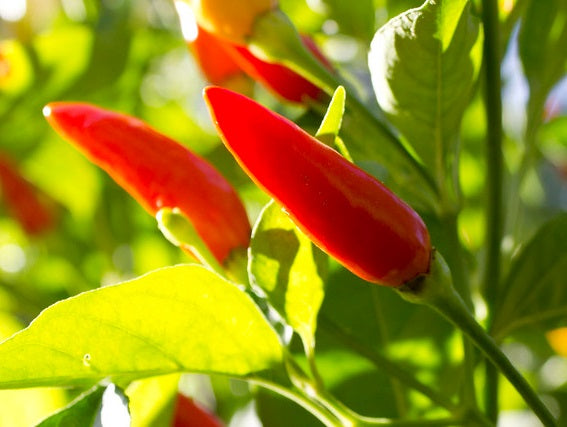Description
The "Thai Bird's Eye" cultivar of Chilli (Capsicum sp.) is highly coveted by spice enthusiasts and chefs for its fiery punch. With slender, pointy chillies that mature from green to a vivid red, and complemented by delicate white flowers that make an appearance in the Birak (early summer) season, this plant offers both aesthetic and culinary delights. Its chillies are renowned for imparting an authentic, spicy zing to Thai dishes, elevating their flavour profile.
For a successful growth journey, plant "Thai Bird's Eye" in well-draining soils; those opting for in-ground planting should enhance sandy soils with a premium soil conditioner. Reveling in full sunlight, this cultivar thrives on consistent watering, though attention to hydration becomes paramount during warmer periods. A sprinkle of general-purpose fertiliser during Djilba (early spring) bolsters its vigour. Come around 70-80 days post planting, the chillies await harvesting, bringing with them an intense heat measured between 50,000 to 100,000 SHU — caution is advised during both consumption and handling due to their fiery nature.
| Botanical Name | Capsicum annuum |
| Common Name | Chilli Pepper |
| Cultivar | Thai Bird's Eye |
|
Classification |
Fruiting and Edible |
| PBR Name | |
| Origin | North, Central, South America |
| Foliage | Evergreen |
| Height | Chilli plants generally grow 60 cm - 1 M |
| Width | Chilli plants generally grow 60 cm - 1 M |
| Light | Full sun |
| Soil | Well-draining, good quality soil is important for good fruit-set. |
| Water Requirement | Though Chilli plants are tolerant of low water, they will fruit better with regular water in warm weather. Reducing watering when fruit is ripening can increase heat levels in the fruit. |
| Lifespan | Perennial |
| Flower Colour | White |
| Flower Time | Depending on when the plant is germinated. Generally flowers from Birak (early summer) to Djeran (autumn) |
| Toxicity | Chilli plants contain Capsaicin, the higher the Scoville Heat Unit (SHU) score, the more capsaicin the plant contains. Capsaicin is toxic to most animals if ingested. Humans can tolerate capsaicin, however it can be toxic at high enough levels, so caution must be taken when ingesting chillis. Capsaicin is also harmful to sensitive areas of the skin in humans and animals. Special care should be taken to avoid the eyes, nasal passage and groin in particular. |
Disclaimer:
Information is intended as a guide only.
Unless otherwise stated, all images are examples only and not photos of the actual plants for sale.
Licensed images are used with permission of the license holder.
Payment & Security
Your payment information is processed securely. We do not store credit card details nor have access to your credit card information.

